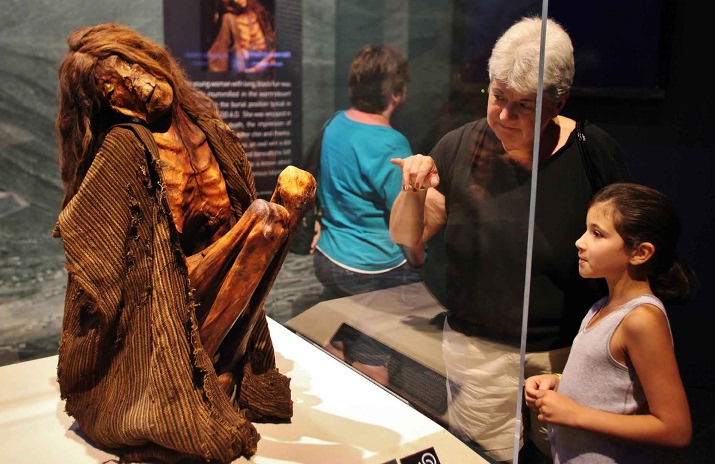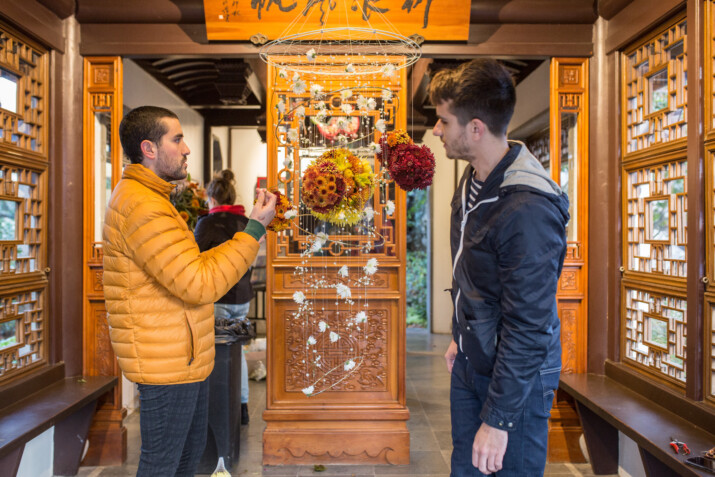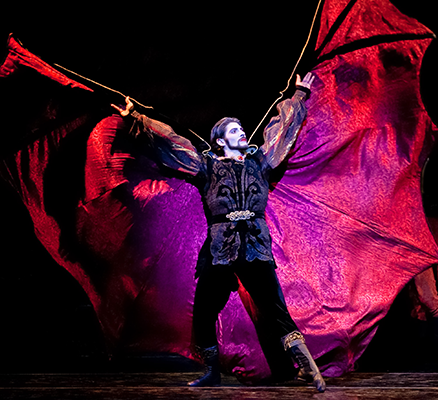Portland, June 13th, 2013. OMSI supporters flocked to the largest exhibition of mummies and related artifacts ever assembled. Mummies of the World presents a compelling collection of naturally and intentionally preserved mummies and artifacts from Asia, Oceania, South America, Europe, as well as ancient Egypt, dating as far back as 6,500 years. Among them are, “The Tattooed Woman.” This young woman with long, black hair was naturally mummified in the warm desert air, seated in the burial position typical in Chile before 1400 A.D. She was wrapped in fabric after her death, the impression of which is still visible on her chin and cheeks. Little is known about the meaning of her mysterious tattoos. (Photo credit: Darryl Moran)
Here’s more information about the exhibit:
Through the use of modern scientific techniques, the mummies in the exhibition have revealed extraordinary details about the past: how tall people were, how long they lived, what kinds of food they ate and what diseases they suffered from. Clothing, jewelry and other personal artifacts placed on or with a mummy can tell us about the person’s status and lifestyle, as well as the values, beliefs, and attitudes of the culture in which they lived.
Plan about 60 to 90 minutes to explore the exhibition.
Mummies of the World is the largest exhibition of mummies and related artifacts ever assembled.
The exhibition includes this never-before-seen collection of 150 objects and specimens including human and animal mummies and related artifacts from South America, Europe, Asia, Oceania and Egypt. Artifacts include Egyptian and South American burial objects including amulets, statues and fragments from the Book of the Dead.
The breathtaking exhibition offers visitors state-of-the-art multi-media and hands-on interactive stations, and along with cutting-edge 3-D animation gives audiences the opportunity to learn how mummies are created, where they come from and who they were.
Using state-of-the-art scientific methods including Computer Tomography (CT), Magnetic Resonance Imaging (MRI), DNA analysis, and radiocarbon dating, researchers provide insight into people from ancient civilizations and cultures of every major region of the world.
The exhibition explains what a mummy is, how mummification occurs both through intentional and natural processes, and that mummies come from all over the world – found in bogs, caves, cellars, deserts and environments all over the globe.
The exhibition was derived from the research of the Germany Mummy Project, led and curated by the Reiss-Engelhorn Museums in Mannheim, Germany, which worked with an international team of scientists from many disciplines to study the mummies. The research is presented in Mummies of the World, and was made possible through the collaboration of 20 world-renowned museums, organizations and collections from seven countries.
Mummies of the World presents an extraordinary, never-before seen collection that has been assembled for a limited three-year U.S. tour. The rare and priceless collections contained in the exhibition will be returned to the loaning institutions after the tour concludes. Learn more information about the exhibition: www.mummiesoftheworld.com.
The exhibition offers visitors state-of-the-art multi-media and hands-on interactive stations along with 3-D animations, transforming audience into amateur “mummyologists” as they learn how mummies
are created, where they come from and who they were.Some of the most fascinating aspects of Mummies of the World include: The Detmold Child, a Peruvian child mummy in a remarkable state of preservation,
radiocarbon dated back 6,420 years – about 3,000 years before the birth of King Tut. The Orlovits family – Michael, Veronica and their son Johannes –who are part of a group of 18th-century mummies discovered in a long-forgotten church crypt in Vác, Hungary in 1994. Baron von Holz, a 17th-century nobleman believed to have died in or near Sommersdorf,Germany during the Thirty Years’ War (1618–48), discovered by
descendants of his relatives in the crypt of the family’s late 14th-century castle. Baroness Schenck von Geiern, another von Crailsheim ancestor, was also discovered in the family crypt.mummiesoftheworld.com
An Egyptian cat mummy elaborately wrapped in painted linen bandaging, dating to the Ptolemaic period. The sarcophagus and mummy of an Egyptian man named Nes-pa-qa-shuti, found in a necropolis at Akhmim, an important site in Egypt with ties to the royal families. He dates back to about 650 B.C. South American mummies including a Pre-Columbian woman found in the Peruvian desert, dating to about 1400 A.D. Complete and partial Egyptian mummies, illustrating both how people were mummified and how the dead were treated. Animal mummies including a howler monkey from Argentina; a lizard mummified in the Sahara desert; and bird, dog, fish and reptile mummies. Artifacts including South American burial objects; Egyptian salts and resins used in the mummification process; fragments of an Egyptian Book of the Dead; and a 19thcentury pharmaceutical price list including an ingredient for medications made from ground mummies. More information about Mummies of the World: www.mummiesoftheworld.com.
The exhibit opened June 14, 2013, and will close September 8, 2013.
Ticket prices are listed below:
Adults (14-62):$21.00
Seniors (63+): $19.00
Students (14+W/ID): $19.00
Youth (3-13):$13.00
Adult Members (14-62): $14.00
Senior Members (63+): $14.00
Youth Members (3-13): $10.00




















